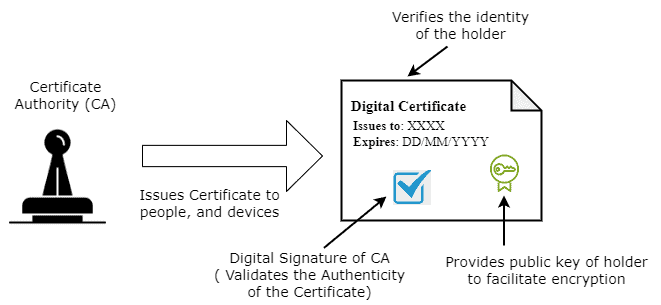Learn through the super-clean Baeldung Pro experience:
>> Membership and Baeldung Pro.
No ads, dark-mode and 6 months free of IntelliJ Idea Ultimate to start with.
Last updated: March 18, 2024
In this tutorial, we’ll talk about the differences between .cer and .pfx file types.
A digital certificate serves as a cryptographic mechanism for verifying the identity in electronic communication. We need these certificates to establish secure online communication channels and ensure digital data’s privacy, authenticity, and correctness.
A digital certificate comprises components such as subject (entity details), issuer (CA information), public key (for encryption/verification), and validity period (start and expiration dates):

The subject contains specifics like common name and organization, the issuer discloses CA details, and the public key corresponds to the entity’s private key, which is crucial for encryption and signature validation. The validity period establishes the certificate’s timeframe, specifying start and expiration dates.
A .cer file, a digital certificate format, contains a certificate usually issued by a Certificate Authority (CA), mainly utilized in security protocols like SSL/TLS to ensure secure internet communication. The file includes information about the certificate recipient, the associated public key, and details about the certificate issuer.
A .cer file can be binary or Base64-encoded, adhering to the X.509 standard that dictates the format for public-key certificates. It outlines structured content, specifying details like subject, issuer, public key, and validity period.
These files serve diverse purposes, including SSL/TLS for website security, code signing for software source verification, and email encryption for secure communication.
A .pfx file, also recognized as a Personal Information Exchange file, is a binary file designed to encapsulate multiple cryptographic components comprising private keys, public keys, and digital certificates. This file type prioritizes security by implementing encryption and self-password protection mechanisms.
Organizations widely use .pfx files to securely store private keys, associated public key certificates, and intermediate certificates, forming a chain. Their key feature is securely bundling and safeguarding sensitive cryptographic data, which is essential for secure email communication, digital signatures, and data encryption.
Password protection enhances .pfx file security, safeguarding the contained private key. Access requires the correct password, ensuring unauthorized users can’t unlock and utilize cryptographic keys. pfx files also support storing attributes like friendly names and extended properties, enabling users to associate meaningful identifiers and metadata with keys and certificates.
These file types are compatible with various systems and platforms, including Windows, MacOS, and Linux.
The key difference between .cer and .pfx files is their content and purpose. A .cer file usually contains only the public key certificate. In contrast, a .pfx file is an all-encompassing container housing private and public key certificates.
The .cer files are commonly used to share public key information, as in scenarios of certificate distribution or SSL/TLS implementations, where secure communication requires providing the server’s public key. Users employ the .pfx file format for secure applications such as digital signatures, secure email communication, and data encryption.
Further, a .cer file is a binary or base64-encoded file, whereas a .pfx file is a binary file. Binary files store data in its raw binary format, while base64-encoded files convert binary data into ASCII text for easier transmission and storage in text-based environments. Binary files are typically more compact as they represent data directly in binary form without additional encoding overhead. In base64 files, 3 bytes of binary data are represented as 4 ASCII characters. This results in an increase in size compared to the original binary data.
Let’s summarize the main differences:
| .cer File Type | .pfx File Type | |
| Content | Contains only the public key and the digital certificate | Contains both the private key and its associated digital certificate(s) |
| Format | Either binary or Base64-encoded X.509 format | Binary file format |
| Security | No need for encryption or password protection | Encrypted and password-protected |
| Conversion | We can convert it to other formats, such as .pem or .der | We can convert it to other formats, such as .pem or .p12 |
| Uses | Typically used for distributing public keys and SSL/TLS server certificates | Mainly used in code signing certificates and client authentication certificates |
These are the five significant distinctions that exist among these file systems.
In this article, we discussed the difference between file types .cer and .pfx. The former typically contains only the public key and the digital certificate. On the other hand, a .pfx file is a more comprehensive container that includes both the certificate and its private key.